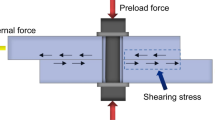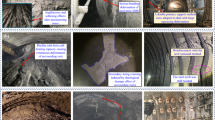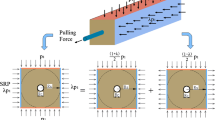Abstract
In this study, we design an integrated manufacturing process for Al6061 alloy bolts to fasten offshore platforms. The proposed scheme includes the theoretical design and numerical study for the heading, trimming, and thread-rolling process. For the theoretical design, the initial rod diameter and the penetration depth (PD) in the thread-rolling process are calculated according to thread standards and geometric relation. The dimensions of the initial workpiece for the heading process are obtained using the volume constancy law. Considering process limitations to predict the defects, the number of stages is set, and the preform is then determined using the design rule in the heading process. Based on the theoretical design, finite-element (FE)-analysis is conducted. In order to predict the defects and fracture phenomena, the ductile fracture criterion was applied during the heading and trimming processes. The Taguchi method is used to optimize the trimming and thread-rolling process with the set of design parameters, such as the PD, transfer velocity, and revolutions per minute in the thread-rolling process, and the blade radius (BR), land width, and stop distance in the trimming process, respectively. Results show that the PD and BR have the most significant effect on the dimensional accuracy and forming load. To validate the proposed design, the aluminum alloy bolt-forming experiment is performed. We obtain the sound Al6061 alloy M12 hexagonal bolt shaped with highdimensional accuracy. Therefore, this research provides valuable guidelines for the design of the integrated forming process in actual bolt production.
Similar content being viewed by others
References
L. H. Chiu, C. Y. Tsai, K. H. Chen, C. J. Hu and H. Chang, Effect of coarse second-phase particles on galvanic corrosion of anodized 6061 aluminum alloy coupled with C1100 copper, Int. J. Electrochem. Sci., 10 (2015) 6572–6585.
Y. Shin and K. Kawai, A study of optimum die-design in the heading process with two blows, Part 1: Experimental study, J. Mater. Proc. Tech., 28 (1991) 391–406.
D. J. Yoon, S. Y. Hahm and Y. S. Lee, A study on forming of Al-Zn-Mg-Sc aluminum alloy bolts, Trans. Mater. Proc., 21 (7) (2012) 447–452.
J. H. Kim, S. W. Chae, S. S. Han and Y. H. Son, Manufacturing process design of aluminum alloy bolt, J. Kor. Soc. Prec. Eng., 27 (5) (2010) 63–68.
Y. G. Jin, H. M. Baek, S. K. Hwang, Y. T. Im and B. C. Jeon, Continuous high strength aluminum bolt manufacturing by the spring-loaded ECAP system, J. Mater. Proc. Tech., 212 (4) (2012) 848–855.
J. S. Choi, S. Nawaz, S. K. Hwang, H. C. Lee and Y. T. Im, Forgeability of ultra-fine grained aluminum alloy for bolt forming, Int. J. Mech. Sci., 52 (10) (2010) 1269–1276.
J. H. Kim, S. K. Hwang, Y. T. Im, I. H. Son and C. M. Bae, High-strength bolt-forming of fine-grained aluminum alloy 6061 with a continuous hybrid process, Mater. Sci. Eng. A, 552 (2012) 316–322.
G. A. Edwards, K. Stiller, G. L. Dunlop and M. J. Couper, The precipitation sequence in Al-Mg-Si alloys, Acta Mater., 46 (11) (1998) 3893–3904.
O. Jensrud and K. Pedersen, Cold forging of high strength aluminum alloys and the development of new thermomechanical processing, J. Mater. Proc. Tech., 80–81 (1998) 156–160.
T. Altan, G. Ngaile and G. Shen, Cold and Hot Forging Fundamentals and Applications, First Ed., ASM International, Ohio, USA (2005).
S. Chen, Y. Qin, J. G. Chen and C. M. Choy, A forging method for reducing process steps in the forming of automotive fasteners, Int. J. Mech. Sci., 137 (2018) 1–14.
W. Feng and L. Hua, Multi-objective optimization of process parameters for the helical gear precision forging by using Taguchi method, J. Mech. Sci. Tech., 25 (6) (2011) 1519–1527.
ASM International, ASM Handbook, Volume 4: Heat Treating, Tenth Ed., ASM International, Ohio, USA (1991).
S. C. Park, W. R. Dong and K. H. Lee, Design of a thread rolling process for manufacturing Al6061-T6 alloy bolt using FE analysis and the Taguchi method, J. Kor. Soc. Mar. Eng., 42 (6) (2018) 443–450.
K. H. Kim, D. H. Kim and B. M. Kim, Determination of optimal blank diameter for the high precision of spindle screw, Trans. Mater. Proc., 11 (8) (2002) 710–715.
J. E. Lee, J. B. Kim, K. Park and S. W. Ra, Investigation into thread rolling characteristics of subminiature screws according to thread shapes, Trans. Kor. Soc. Mech. Eng. A, 40 (11) (2016) 971–978.
ASME, Metric Screw Threads: M Profile (B1.13M-2005), ASME, New York, USA (2005).
ASME, Metric Formed Hex Screws (B18.2.3.2M-2005), ASME, New York, USA (2005).
T. Heinz, Metal Forming Practise: Processes - Machines - Tools, Springer Berlin Heidelberg, Berlin, Germany (2006).
K. Lange, Handbook of Metal Forming, First Ed. Society of Manufacturing Engineers, Michigan, USA (1995).
T. Altan, S. I. Oh and H. L. Gegel, Metal Forming: Fundamentals and Applications, First Ed., American Society for Metals, Ohio, USA (1983).
H. S. Kim, Y. T. Im and M. Geiger, Prediction of ductile fracture in cold forging of aluminum alloy, J. Manuf. Sci. Eng., 121 (3) (1999) 336–344.
H. Y. Cho, W. J. Kim, S. J. Lee, N. K. Park and S. H. Lee, Finite element analysis for forging of nonaxisymmetric cam bolt, Annuals Spring Conf. Kor. Soc. Mech. Eng. (2007) 965–970.
M. Li, An experimental investigation on cut surface and burr in trimming aluminum autobody sheet, Int. J. Mech. Sci., 42 (5) (2000) 889–906.
C. McCormack and J. Monaghan, A finite element analysis of cold-forging dies using two- and three-dimensional models, J. Mater. Proc. Tech., 118 (1-3) (2001) 286–292.
S. C. Park and K. H. Lee, Design of the trimming process of an Al6061 alloy bolt head using finite element analysis and the Taguchi method, J. Kor. Soc. Mar. Eng., 42 (10) (2018) 800–806.
C. MacCormack and J. Monaghan, Failure analysis of cold forging dies using FEA, J. Mater. Proc. Tech., 117 (1-2) (2001) 209–215.
J. Petruska, J. Borkovec, J. Hulka and R. Foret, Application of ductile fracture criteria to industrial cutting processes, Adv. Mater. Res., 264–265 (2011) 913–918.
J. P. Domblesky and F. Feng, Two-dimensional and three-dimensional finite element models of external thread rolling, Proc. Inst. Mech. Eng. B: J. Eng. Manuf., 216 (4) (2002) 507–517.
P. Kramer and P. Groche, Defect detection in thread rolling processes - experimental study and numerical investigation of driving parameters, Int. J. Mach. Tools. Manuf., 129 (2018) 27–36.
Acknowledgments
This work was supported by the National Research Foundation of Korea (NRF) grant funded by the Korea government (MSIP; Ministry of Science, ICT & Future Planning) (No. 2017R1C1 B5017016).
Author information
Authors and Affiliations
Corresponding author
Additional information
Recommended by Guest Editor Maenghyo Cho.
Sung-Cheol Park received his B.S. degree (2014) from Korea Maritime and Ocean University in Korea. Mr. Park is currently getting a master's degree at Division of Marine Engineering in Korea Maritime and Ocean University in Korea. His major research field is metal forming technologies including forging and thread-rolling.
Dong-Hoon Lee received his M.S. degree (2003) from Pusan National University in Korea. Mr. Lee is currently a Department Head in S&T Motive. His major research field is metal forming technologies including cold/hot forging and stamping.
Kyung-Hun Lee received his Ph.D. (2013) from Pusan National University in Korea. Dr. Lee is currently an Assistant Professor at Division of Marine Engineering in Korea Maritime and Ocean University in Korea. His major research field is metal forming technologies including wire and shape drawing, rolling, shape rolling, ring rolling, and cold/hot forging process.
Rights and permissions
About this article
Cite this article
Park, SC., Lee, DH., Ko, DC. et al. Integrated process design of Al6061 alloy bolts for fastening offshore platforms. J Mech Sci Technol 33, 3695–3707 (2019). https://doi.org/10.1007/s12206-019-0711-5
Received:
Revised:
Accepted:
Published:
Issue Date:
DOI: https://doi.org/10.1007/s12206-019-0711-5




